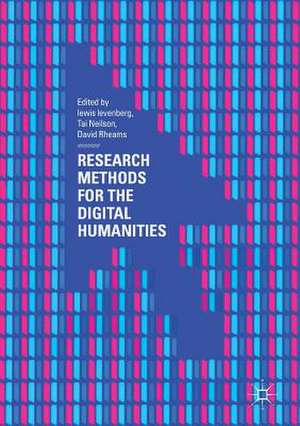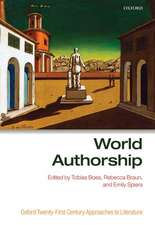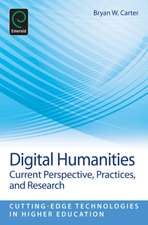Research Methods for the Digital Humanities
Editat de lewis levenberg, Tai Neilson, David Rheamsen Limba Engleză Paperback – 13 noi 2018
Preț: 321.54 lei
Nou
61.53€ • 64.01$ • 50.80£
Carte tipărită la comandă
Livrare economică 14-28 aprilie
Specificații
ISBN-10: 3319967126
Pagini: 311
Ilustrații: XVII, 325 p. 52 illus., 44 illus. in color.
Dimensiuni: 148 x 210 x 20 mm
Greutate: 0.41 kg
Ediția:1st ed. 2018
Editura: Springer International Publishing
Colecția Palgrave Macmillan
Locul publicării:Cham, Switzerland
Cuprins
Recenzii
Notă biografică
Textul de pe ultima copertă
Caracteristici
Each chapter provides a step-by-step guide to cutting-edge methodologies so that students can make informed decisions about the methods they use, consider ethical practices, follow practical procedures, and present their work effectively
Takes a very practical approach to the subject, allowing students to get to grips with it quickly and develop their own approaches
Descriere
This volume introduces the reader to the wide range of methods that digital humanities employ, and offers a practical guide to the study, interpretation, and presentation of cultural material and practices. In this instance, the editors consider digital humanities to include both the use of computing to understand cultural material in new ways, and the application of theories and methods from the humanities to interpret new technologies. Each chapter provides a step-by-step guide to cutting-edge methodologies so that students can make informed decisions about the methods they use, consider ethical practices, follow practical procedures, and present their work effectively.
Readers will develop practical and reflexive understandings of the software and digital devices that they study and use for research, and the book will help new researchers collaborate and contribute to their scholarly communities, and to public discourse. As contemporary humanities work becomes increasingly interdisciplinary, and increasingly permeated by and with digital technologies, this volume helps new researchers navigate an evolving academic environment. Humanities and social sciences students will find this textbook an invaluable resource for assessing and creating digital projects.























